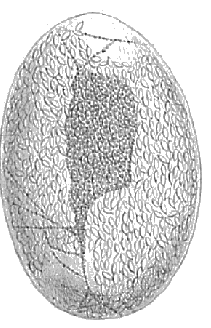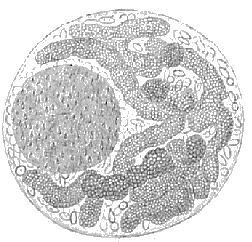
Introduction to the Apicomplexa
Parasitic, pathogenic protists
In traditional
protist taxonomy,
most parasitic protists were placed in the
class Sporozoa. This group has since been found to include protists from a
number of unrelated lineages, and has been dropped from current usage. However,
many of the protists in the old Sporozoa share certain structural features,
in particular an apical complex of microtubules within the cell. These
protists have now been grouped in the Apicomplexa, probably the largest and
best-known taxon of parasitic protists. There are about 4,000 known species,
but this is almost certainly a gross underestimate of the actual number.
There are no known fossil apicomplexans. However, the group is a very
important part of the living biota. Apicomplexans infect both invertebrates and
vertebrates;
they may be relatively benign or may cause serious illnesses. Species in the
genus Plasmodium cause malaria in humans and other animals; an
estimated 300 million people in over 90 countries are infected with malaria,
and over 1 million die from it each year. Other apicomplexans cause serious
illnesses, such as coccidiosis and toxoplasmosis, in humans and domestic
animals.
On the other hand, apicomplexans that infect
insects
have been used experimentally to control populations of insect pests.
 Apicomplexans have complex life cycles, and there is much variation among
different apicomplexan groups. Both asexual and sexual reproduction are
involved, although some apicomplexans skip one or the other stage.
The basic life cycle may be said to start
when an infective stage, or sporozoite, enters a host cell, and then
divides repeatedly to form numerous merozoites. Some of the merozoites
transform into sexually reproductive cells, or gamonts. Gamonts join
together in pairs and form a gamontocyst (pictured above). Within the
gamontocyst, the gamonts divide to form numerous gametes. Pairs of
gametes then fuse to form zygotes, which give rise by meiosis to
new sporozoites,
and the cycle begins again. Apicomplexans are transmitted to new hosts in
various ways; some, like the malaria parasite, are transmitted by infected
mosquitos, while others may be transmitted in the feces of an infected
host, or when a predator eats infected prey.
Apicomplexans have complex life cycles, and there is much variation among
different apicomplexan groups. Both asexual and sexual reproduction are
involved, although some apicomplexans skip one or the other stage.
The basic life cycle may be said to start
when an infective stage, or sporozoite, enters a host cell, and then
divides repeatedly to form numerous merozoites. Some of the merozoites
transform into sexually reproductive cells, or gamonts. Gamonts join
together in pairs and form a gamontocyst (pictured above). Within the
gamontocyst, the gamonts divide to form numerous gametes. Pairs of
gametes then fuse to form zygotes, which give rise by meiosis to
new sporozoites,
and the cycle begins again. Apicomplexans are transmitted to new hosts in
various ways; some, like the malaria parasite, are transmitted by infected
mosquitos, while others may be transmitted in the feces of an infected
host, or when a predator eats infected prey.
For additional information:
Biomedical information about Plasmodium and malaria is available from
the Malaria Database
maintained at Monash University, Australia. A good epidemiological overview
of human malaria is presented by the
World Health
Organization.
Information on apicomplexans that infect domestic animals
is available from
Oklahoma
State University College of Veterinary Medicine or from the
Cryptosporidium Research lab
at Kansas State University.
General information on various pathogenic apicomplexans is
available through MicroWeb.
Life stages of gregarine
apicomplexans are portrayed in this 19th-century
zoological chart
preparted by the great zoologist and parasitologist Rudolph Leuckart.

Source:
Levine, N. D. 1985. Phylum II. Apicomplexa. In: Lee, J.J., Hutner,
S.H., and Bovee, E.C. (eds.) An Illustrated Guide to the Protozoa.
Society of Protozoologists, Lawrence, Kansas.


 Apicomplexans have complex life cycles, and there is much variation among
different apicomplexan groups. Both asexual and sexual reproduction are
involved, although some apicomplexans skip one or the other stage.
The basic life cycle may be said to start
when an infective stage, or sporozoite, enters a host cell, and then
divides repeatedly to form numerous merozoites. Some of the merozoites
transform into sexually reproductive cells, or gamonts. Gamonts join
together in pairs and form a gamontocyst (pictured above). Within the
gamontocyst, the gamonts divide to form numerous gametes. Pairs of
gametes then fuse to form zygotes, which give rise by meiosis to
new sporozoites,
and the cycle begins again. Apicomplexans are transmitted to new hosts in
various ways; some, like the malaria parasite, are transmitted by infected
mosquitos, while others may be transmitted in the feces of an infected
host, or when a predator eats infected prey.
Apicomplexans have complex life cycles, and there is much variation among
different apicomplexan groups. Both asexual and sexual reproduction are
involved, although some apicomplexans skip one or the other stage.
The basic life cycle may be said to start
when an infective stage, or sporozoite, enters a host cell, and then
divides repeatedly to form numerous merozoites. Some of the merozoites
transform into sexually reproductive cells, or gamonts. Gamonts join
together in pairs and form a gamontocyst (pictured above). Within the
gamontocyst, the gamonts divide to form numerous gametes. Pairs of
gametes then fuse to form zygotes, which give rise by meiosis to
new sporozoites,
and the cycle begins again. Apicomplexans are transmitted to new hosts in
various ways; some, like the malaria parasite, are transmitted by infected
mosquitos, while others may be transmitted in the feces of an infected
host, or when a predator eats infected prey.



